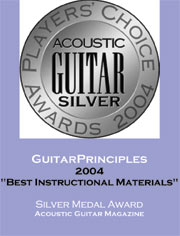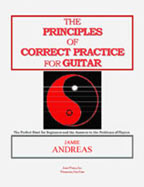Many people begin to play the guitar by learning the guitar chords to their favorite song, and trying to change them . In fact, I learned this way. There are many things to be aware of while doing this. There are things to know and do that can make it easier, and guarantee you will have success. There are also many things that can go wrong, and guarantee trouble.You should first understand that often the term "simple chords" is very misleading. Most "simple chords" for guitar require quite complex movements of the fingers, in order for them to get into the final "form" of the chord. In the following essay, I am going to analyze one of the most common chord changes, and one of the most misunderstood in terms of its actual difficulty. I am referring to the chords G and C.
Let's look at this chord change from the viewpoint of the ideas outlined in " The Principles of Correct Practice For Guitar". And I am also going to use a real life example of a student of mine named Kathy. You will see many things in her story that will be true for you also, and the principles will apply to all chord changes, not just G and C.
Kathy's SituationWhen Kathy came for lessons with me, she had already been trying to learn the guitar for about 2 years, with a few different teachers, and with no success. She could struggle her way into a few chords, but watching her try to change them fast enough to do a song was an exercise in agony, for me and for her. Her case is a good example of how bad things can get when there is no understanding of the mechanics of playing and practicing, right from the beginning.
First of all, I needed to make her aware of how tensed up her left shoulder was as soon as she began to raise her left hand to the neck. This made her whole arm tense, right down to the fingers. As she tried to get in to the first chord, the fingers tensed up even more, and started leaning and pressing against one another, instead of having the proper space between them.
This tension of the fingers immediately began to cause a reaction in the rest of the arm, tensing up the large muscles of the arm and shoulder. All of this created a great feeling of discomfort, that Kathy had assumed is "just the way it feels to do a G chord."
How To Avoid "Lockup"This is a situation that happens all the time to beginners, and even to advanced players to varying degrees. I call this buildup of tension as the arm is raised and the fingers about to move lockup. That is, the fingers, hand and arm "lockup" with tension, and usually the unfortunate player continues to try to get them in position by working through the tension, trying to make the fingers perform while they are "locked up".
The thing to do is stop, go back into the position you were coming from, and begin to move very slowly, examining the fingers closely as soon as they release the first chord, and focus on staying relaxed from the shoulder down to the fingers, and staying that way as the fingers move to their new positions.
Now, you have to look at the whole situation the hand is in. For Kathy, her thumb was wrapped around the neck in such a way that there was no space between her hand and the guitar, so her fingers had a difficult time, not being free and relaxed, or having the room to move. By the time she got in to the G chord, she was holding on to it for dear life! Not exactly in a position to easily change to the C chord, which is even harder.
Then, as she began to pry her fingers off the G chord and go for the C, she did what many people do, she led with the strong finger, the first finger, that is, and smashed it down on it's note, on the second string, first fret. Now, she was holding on to that for dear life, with the whole arm, from finger tip to shoulder, knotted up with tension.
Next came the attempt to get fingers 2 and 3 into position, which was very difficult for her to do, and me to watch, as those poor, stressed out fingers did their best to do her will. By the time she got them in to position, somewhat, they weren't standing straight enough to allow the adjacent strings to ring clearly, one of the difficulties of the C chord.
So the net result of all this effort was the inability to change chords smoothly, and the inability to get the notes of the C chord out clearly once she got there.
My Solution for KathyHere are the steps I used to undo the knots of tension that Kathy had unknowingly created and allowed, that were preventing her from performing actions on the guitar which anyone should be able to do, if they approach them properly.
So extra tension in the muscles, which every advanced player knows is the number one cause of playing difficulty, becomes a blind spot for us. Usually we are only aware of the result of the tension, which is that mistake we just made. Often it happens we are not even aware of that, because we start to filter out those unpleasant reminders of our troubles. As you will see shortly, the correct approach to dealing with "mistakes" caused by tension, is to repeat the movement extremely slowly, with a great focus on keeping all muscles relaxed. With each repetition, the muscles learn the relaxed way of moving to produce the result you want. "
So you see, it is lack of understanding of how the body/mind functions, and lack of honest attention while practicing, that gets us in to trouble.
You must start to observe your own "Tightness", and replace it with "Lightness", then you will see your level as a player change upward, what I call Vertical Growth. Since many players have no idea what this lightness feels like, here is a very simple way to connect with it. You must then begin to cultivate this feeling in actual playing. Believe me, it feels good! In fact, when you see a good player "making it look easy", it's because it is easy, when you have the "Incredible Lightness".
Let's discover "The Light Finger"
The first step in finding "The Incredible Lightness" is to discover The Light Finger. The Light Finger is the completely relaxed finger, brought to the string, and touching the string, with only the weight of the finger. It does not press the string down until told to do so. To discover the sensation of the Light Finger, do this:
1. 2. 3. 4. 5. 6. 7. 8. 9. 10. I really believe that without this approach, she would never have unlocked the tensions that were preventing her from being able to do these chord changes. This approach will work for anybody, and any chords. Try it, with these chords, or any other changes that give you trouble, or that you would like to improve.
Copyright 1999 Jamie Andreas. All rights reserved.
Free! 10 Things You Can Do Right Now to Become a Better
Guitarist! “The Principles of Correct Practice for Guitar,” the Perfect
Start for Beginners, the Answer to the Problems of Players. Start to play the
guitar without getting bad habits, or get rid of the bad habits you already
have, by knowing how to do "perfect practice" with the Principles of Correct
Practice for Guitar.
Visit:
www.guitarprinciples.com

The Principles of Correct Practice for Guitar
Every day, people the world over are telling their own story of amazing progress and long sought revelations about how to, finally, get good on the guitar.
"The Principles of Correct Practice for Guitar" shows beginners how to start playing without getting bad habits, and also shows players how to get rid of the bad habits they have!Fantastic results are guaranteed with "The Principles"! This is not some "hit or miss, works for some people, not for others" method for guitar. "The Principles" works for everybody who uses it!!
"The Principles" contains the greatest wealth of secret knowledge about how to be a great guitarist that you will ever find! This is not another idle statement about some guitar book: it is a proven fact, proven, and testified to, by thousands of players around the world.
See excerpts from "The Principles".....
77 Pages, 39 Photos, Spiral bound.
Only $28.95 Buy Now!"The Principles Of Correct Practice For Guitar" has, for the first time, summarized and presented ALL of the essential knowledge you need to be a master guitarist (or just a good one who has fun and sounds good!).
And most importantly, "The Principles" shows you HOW to USE that information when you practice, and exactly what you need to DO to become the guitar player you want to be!
Join the thousands of players making incredible progress in their playing, GET THE PRINCIPLES TODAY!
For more information click here!
